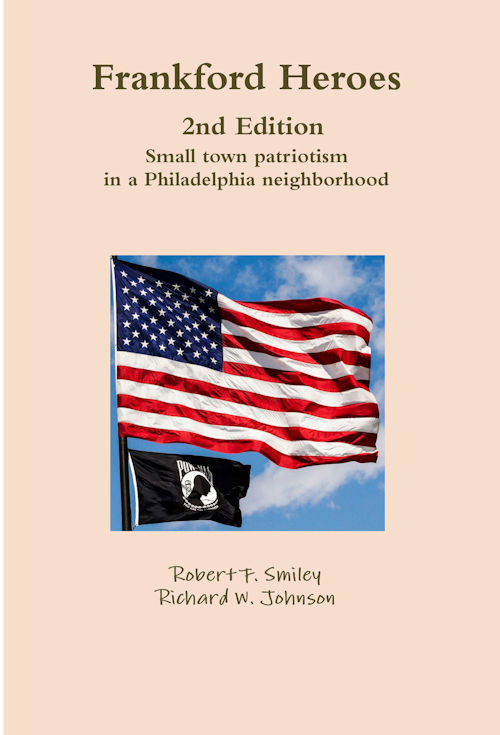I’m really drawn to this intersection. I don’t think it would be wrong to say that this area was the center of mill work around the Frankford Creek. And a good portion of the mills are still intact(ish).
Before and After: Wingohocken and Adams Ave
8 thoughts on “Before and After: Wingohocken and Adams Ave”
Comments are closed.







Jim, thanks for posting another great pic… The mills carry a certain fascination for me. I grew up on Penn Street. Behind my house and down Leiper Street, was the old Arotex (sp?) Mill. I clearly remember many hot summer nights, laying in my bed, (it was too hot to sleep) listening to the clanking sounds of the textile machines on third shift going back and forth; they would intermittently slow down; in the interim, you would hear other sounds- like car engines, distant and near, racing up and down the streets- it was the bad boys in their big hemi powered cars, and indistinguishable voices. Then the textile machines would start up again and weave all the sounds together until it lulled you to sleep. During the day, I looked through the wire meshed windows– the space was dingy and mysterious, with creepy lighting; and the machines sounded so menacing! During lunch, the workers would hang out the Leiper Street side balcony on the second floor. There was always this one guy with a mean face and red hair. Probably was a hot and difficult job.
About the Arotex Mill. I googled it and found “Arotex Mills Inc” and found it to be at 1400 Unity Street. That’s a really old mill listed on the website Workshop of the World: Aramingo Mills. It was built in 1865!
The part of the building in the pic (far side) with the red brick facade is where they had to chop a portion of the building to allow enough clearance for the widening of Wingohocking St back in the 40s or 50s. I believe there are many photos on phillyhistory.org that show the building prior to this happening.
Warren
The building chopping off is going to be a future before and after, I was very surprised to see those old pics. It’s almost cut in half, seems to me they’d be just as well off tearing it down and putting it back up 20 feet over.
great before & after. I really enjoy seeing what my neighborhood looked like and the history behind it.
This area of Frankford has also intrigued me for years. The building has all the characteristics indigenous to a grist mill.
I identified this particular building as being one that was built by Stephen Decatur, the Elder, as part of his mill complex, circa 1802-04, as it is shown on the 1808 John Hills Map:
http://www.philageohistory.org/rdic-images/index2.cfm?w=HSF.D2G1
Dr. James Farley, Northeast Catholic High School- Professor Emeritus authored a book: Making Arms in the Machine Age: Philadelphia’s Frankford Arsenal, 1816-1870. The picture is in the book on page three but may not show on Google:
http://books.google.com/books?id=hXfjNp2DeJ8C&pg=PA3&dq=%22Oswald+Eve's+gunpowder%22+%22Farley%22&hl=en&ei=DrI7Tc-7Msqs8AaFqvTuCg&sa=X&oi=book_result&ct=result&resnum=1&ved=0CCMQ6AEwAA#v=onepage&q&f=false
I spoke to Dr. Farley, as I disagreed with much of his information on this particular part of his book. He and I still disagree.
On a high note, Torben Jenk has hit the nail on the his with his: “Work Shop of the World.”
He put a lot of energy in building an excellent web-site covering all of Philadelphia.
Torben has hyperlinked much of the info to the Heximer Surveys (which tell their own story on any particular location) and to the Library of Congress -maps and other vital information.
http://www.workshopoftheworld.com/frankford/tremont.html
Torben Jenk is very professional and gives great lectures and power point presentations – and he is a nice guy! He will always take the time to answer a question.
J.M.
Dr Farley taught me AP history!
Most of this is all free and public information with no restriction on it’s use.
I have studied many antiquated surveys of this area, and this view is the proper view.
http://www.philageohistory.org/rdic-images/view-image.cfm/HGSv19%2E1760%2D1761
Zoom in on the the two buildings that were built by father of Commodore Stephen Decatur.
You will notice that they are not numbered – why?
Probably because they were there before the rest of the buildings.
Read the data – they were vacant – being used only for storage.
The mill-race and water wheel on this type of grist mill would have been located inside the (basement) building. Notice the discharge just above the word “CREEK.”
This particular mill was probably not even fed from the Frankford Creek.
I believe it was being fed from the watercourse that ran through Northwood Park.
That small run fed into a large pond located where the baseball field of Simpson Playground.
This pond formed the reservoir for the Frankford Dye, Bleach & Finishing owned by the Horrocks Brothers.
http://www.philageohistory.org/rdic-images/view-image.cfm/HGSv18%2E1729%2D1730
The discharge water from the Horrocks Mills then continued it’s decent down Adams Road – then crossing under the road by a a small viaduct feeding into the Grist Mill Buildings.
I must mention that there may have also been a mill there even before Horrocks as the Hills Map of 1808 show two mills on Adams Road – not on Frankford Creek.
Everyone must do their own research.
So this is some of my research, and I may be right or I may be wrong.
I hope when I eventually quote myself on this, that I will not latter be accused of plagiarism of my own words – as people just cut and past without giving any credit or attribution as if they really did some work or research.
There are real cases where this has happened. So quote me if you want, as this is all just my opinion.
Joe Menkevich